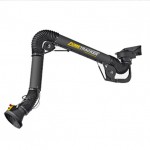Problem: Oil Mist
Machining processes produce many hazardous contaminants that origins from the metalworking fluids. Machinists are usually well aware of the safety hazards associated with operating machines. Less known are the health hazards associated with the use of metalworking fluids. During milling, turning, grinding and boring (and other metal-cutting machining activities) metalworking fluids form a mist of small droplets. The oil mist is suspended in the air and can be inhaled and ingested. When these fluids form into a mist during the machining process the larger droplets can pass into the nose and windpipe and can be swallowed. The smaller droplets can deposit into the lungs. This can off course be unhealthy and very irritating to the eye, nose and throat.
Threshold Limit Value (TLV)
Every country has its own TLV value that will set the standard of the indoor air quality in the plant. The TLV values in the field of coolant mist/smoke are given in mg/m3. The measurement is always taken in or near the breathing zone of the operator. This means that the TLV value will give information about how much coolant mist/smoke is acceptable for the operator to inhale.
Corporate Limit Value
In many countries the legislations are not up to the industrial standard or only recommendations. Therefore many multinational companies are setting their own hygienic limit value in own Global Production Standards. The reason for doing this is to make sure that air quality is kept at the best possible level, making sure that production can follow the quality standards in every country where the company is active.
Short Term Value (STV)
The STV is an accepted short term exposure to the contaminant. Normally for periods not exceeding 15 minutes and repeated maximum 4 times per day with at least 60 minutes between each exposure. Most countries also have regulations for STV but they are not as well known as the TLV values.
Solution:
The most economical solution for capturing oil mist is at the source. This can be accomplished by either an air cleaner mounted on each CNC machine or lathe, or a large central modular “Mist Eliminator” ducted to each machine. The MistEliminator has several options for mist or oily-smoke fumes. A HEPA after filter can be used to recirculate the air back in to the workplace, thereby reducing your heating and ventilation costs.
Oil Mist Products

Fume Tracker Capture Arm
Duis imperdiet at lacus sit amet sagittis. Fusce iaculis nibh vel ex congue, at porttitor turpis commodo. Nulla faucibus vehicula mi, et sodales sem rhoncus quis. Phasellus feugiat elit ut eros rhoncus, sed sagittis nisi vulputate. Vivamus ipsum ante, porta...
Learn More

